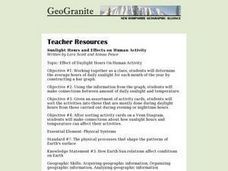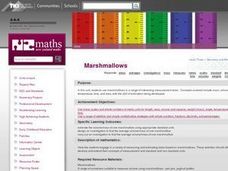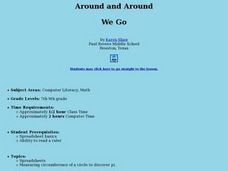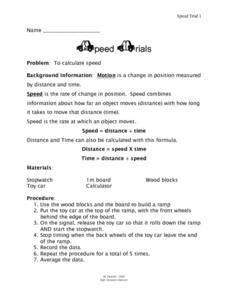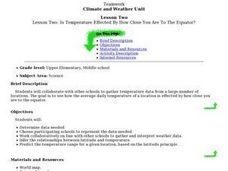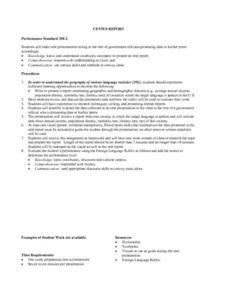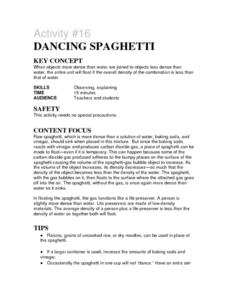Average Teacher Resources
Find Average lesson plans and worksheets
Showing 4,073 resources
Curated OER
Can You Calculate the Speed of Your Pet?
Middle schoolers analyze the formula for speed and velocity. They explore and demonstrate how to calculate the speed of wind up toy pets, average the speeds and identify the correct units of measure of speed.
Curated OER
Effect of Daylight Hours on Human Activity
Students determine the average hours of daily sunlight for each month of the year by constructing a bar graph. They develop a understanding of how the amount of daylight hours varies by month and how that affects both temperature and...
Curated OER
The Impact of Civil War and Conflict on Identity
Young scholars define citizenship and nationality, examine economic impacts of domestic conflict or war on average citizen, view Powerpoint presentation on Kosovo conflict, and complete critical thinking questions.
Curated OER
Marshmallows
Third graders estimate the volume and mass of one marshmallow using appropriate standard units. They design and carry out an investigation to find the average of volume/mass of one marshmallow.
Curated OER
Pumped Up Gas Prices
Learners spend one month keeping track of the mileage and gasoline amounts they or their family has used. Information is entered into a spreadsheet to help calculate the average gas prices over time.
Curated OER
Words In The News
Students discuss human pregnancy, average weight, length and premature birth rates. They review new vocabulary and read a text about the premature birth of a baby and then answer a given set of questions to check for reading comprehension.
Curated OER
Line Graphs
Seventh graders create a line graph and identify when to use line graphs. In this line graphs lesson, 7th graders analyze the average temperatures of various cities. Students graph the data they collected.
Curated OER
Around and Around
Students create a spreadsheet to record information about circular objects. They measure and record information from a variety of objects. Students calculate the ratio of the circumference to the diameter of each object. They find the...
Curated OER
Comparing Temperatures in Different Cities
Students generate a spreadsheet to calculate average daily temperature. They create graphs from spreadsheet data and comprehend the components of the a spreadsheet.
Curated OER
Mean, Mode, Range, Median
In this weather worksheet, students look at the average monthly temperatures and precipitation for their own city to determine the mean, mode, range, and median. This worksheet has 8 fill in the blank questions.
Curated OER
Speed Trails
In this Algebra I/Algebra II worksheet, students conduct an experiment with toy cars in order to calculate and compare average, instantaneous, and constant speed. The two page worksheet contains three questions. Answers are...
Curated OER
The Barbie Problem
In this secondary mathematics worksheet, high schoolers determine the average cost of one Barbie doll given information regarding the sales amounts and frequency of the purchases. The one page worksheet contains one problem...
Curated OER
Probability
Eighth graders relate real life events with probability. In this probability lesson, 8th graders investigate using coin toss, discuss NBA shooting percentages and MLB batting averages. Students also complete a worksheet.
Curated OER
Uncommon Americans
Students view a documentary called, Uncommon Americans, a special presentation of Biography, highlights the efforts of three extraordinary average citizens who have made a difference in their communities. Discussion and a creative...
Curated OER
Climate and Periodic Functions: Science & Math Integration
Students complete a lab that introduce the scientific concept of climate on Earth. Following the lab, they complete further research on climate. Using average monthly temperatures students construct a mathematical model and analyze the...
Curated OER
Is Temperature Effected By How Close You Are to the Equator
Students collaborate with other schools to gather temperature data from a large number of locations. They determine how the average daily temperature of a location is affected by how close you are to the equator.
Curated OER
FILLING IN THE GAPS - Acquiring and Analyzing Satellite and Ground-Based Data
Students monitor rainfall, compute daily averages, and compare their methods of computation to those used by actual researchers using satellite observations.
Curated OER
Anne Frank: Rescuers
Tenth graders examine how heroic behavior is done by average people who stay true to their beliefs. They investigate how discrimination can be prevented.
Curated OER
Discovering a Law of Space Physics
Students use data collected by an astronomer to determine the relationship between the time it takes the planet to orbit the sun and the average radius of the planet's orbit around the sun. Students use trial and error to find the...
Curated OER
Census Report
Learners write and or present a report contrasting geographic and demographic features (e.g., average annual income, population density, mortality rate, literacy rate) of countries where the target languages is spoken to the U.S. They...
Curated OER
Self Portraits
Student pictures are taken with a digital camera. The picture is opened on the computer, and selected. On the computer, the image is cloned, and traced (using the computer, not a "real" pencil). Young scholars discuss how well the...
Curated OER
Caloric Expenditure in Powwow Dancing
Sixth graders investigate the meaning of different types of Native American music and dance. They determine how this music and dance has contributed to modern music and dance. They problem solve to determine the average length of the...
Curated OER
Memory/Physiology Lab Activity
Students investigate the nervous system and how physical distractions influence mental performance. They work in pairs as a researcher and subject and memorize a series of words with no distractions. After repeating the list of words,...
Curated OER
Activity #16 Dancing Spagehetti
Students experiment with floating the spaghetti, the gas functions like a life preserver. Pupils comprehend that a person is slightly more dense than water. They comprehend that a life preservers are made of low-density materials. The...



